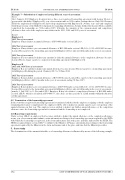Page 362 - SAIT Compendium 2016 Volume2
P. 362
IN 20 (6) Income Tax acT: InTeRPReTaTIon noTes IN 20 (6)
Example 7 – Substitution of employers having different years of assessment
Facts:
On 1 January 2013 Employer G entered into a three-year registered learnership agreement with Learner H (not a person with a disability). Employer G’s year of assessment ends on 31 December. Assume that on 1 July 2014 Learner H left the employment of Employer G and took up employment with Employer K (30 June year- end) and complied with the provisions of the Skills Development Act regarding substitution. Assume further that Learner H successfully completed the learnership on 31 December 2015. Calculate the amounts of the commencement and completion allowances that each of the employers may deduct in the 2013, 2014 and 2015 years of assessment.
Result:
Employer G
2013 Year of assessment
Employer G may deduct an annual allowance of R30 000 under section 12H(2)(a).
2014 Year of assessment
Employer G may deduct a pro rata annual allowance of R15 000 under section 12H(2)(b) (6 / 12 × R30 000) because Learner H is a party to the learnership agreement with Employer G for only six full months in the year of assessment.
2015 Year of assessment
Employer G is not entitled to deduct any amount for either the annual allowance or the completion allowance because Learner H is no longer a party to a registered learnership agreement with Employer G.
Employer K
2013 and 2014 Years of assessment
Employer K is not entitled to deduct any annual allowance because Learner H is not a party to a learnership agreement with Employer K during the period 1 January 2013 to 30 June 2014.
2015 Year of assessment
Employer K may deduct an annual allowance of R30 000 because Learner H is a party to the learnership agreement with Employer K for a full 12 months in the year of assessment ending 30 June 2015.
2016 Year of assessment
Employer K may deduct a pro rata annual allowance of R15 000 under section 12H(2)(b), (6 / 12 × R30 000) because Learner H is a party to the learnership agreement with Employer K for only six full months in the year of assessment, namely, 1 July 2015 to 31 December 2015. Employer K may also deduct a completion allowance of R90 000 under section 12H(4), which is calculated as R30 000 × 3, since there are three periods of 12 full months within the duration of this agreement.
4.9 Termination of the learnership agreement
In the event that a registered learnership agreement is terminated (whether by the employee resigning or by the employer terminating the learner’s employment), the employer will be able to deduct an amount equal to a pro rata portion of the annual allowance in that year. The employer is not entitled to deduct any further annual allowance or the completion allowance since the learnership agreement is terminated and the learnership is not completed.
4.10 Reporting requirements
Under section 12H(8) an employer that becomes entitled to deduct the annual allowance or the completion allowance in any year of assessment must submit certain information relating to that learnership agreement required by the SETA with which the learnership is registered, in the form and manner and at the place and time indicated by the SETA. The SETA is required under section 12H(7) to submit to the Minister of Finance any information relating to that learnership agreement required by the Minister in the form and manner and at the place and time that the Minister prescribes.
5. Case study
The determination of the amount deductible as a learnership allowance is illustrated by means of the following example:
354 saIT comPendIum oF Tax LegIsLaTIon VoLume 2


